目录
1.线性布局 LinearLayout
线性布局内部视图之间的排列顺序是固定的,要么从左到右排列,要么从上到下排列。在xml文件中,LinearLayout通过属性android:orientation区分两种方向,有从左到右horizontal和从上到下vertical两种。默认为horizontal(水平方向)。
示例
<LinearLayout xmlns:android="http://schemas.android.com/apk/res/android"
android:layout_width="match_parent"
android:layout_height="match_parent"
android:orientation="vertical">
<LinearLayout
android:layout_width="match_parent"
android:layout_height="wrap_content"
android:orientation="horizontal">
<TextView
android:layout_width="wrap_content"
android:layout_height="wrap_content"
android:text="横排第一个"
android:textSize="17sp"
android:textColor="#000000" />
<TextView
android:layout_width="wrap_content"
android:layout_height="wrap_content"
android:text="横排第二个"
android:textSize="17sp"
android:textColor="#000000" />
</LinearLayout>
<LinearLayout
android:layout_width="match_parent"
android:layout_height="wrap_content"
android:orientation="vertical">
<TextView
android:layout_width="wrap_content"
android:layout_height="wrap_content"
android:text="竖排第一个"
android:textSize="17sp"
android:textColor="#000000" />
<TextView
android:layout_width="wrap_content"
android:layout_height="wrap_content"
android:text="竖排第二个"
android:textSize="17sp"
android:textColor="#000000" />
</LinearLayout>
</LinearLayout>
效果: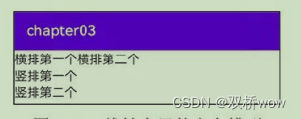
除了方向之外,线性布局还有权重的概念,指的是线性布局的下级视图各自拥有多大比例的宽和高,通过layout_weight进行设置,一旦设置了这个值,就要求layout_width或layout_height填0dp,哪个值填0dp,下级视图就从对应方向按照权重分割布局。
示例
<LinearLayout
android:layout_width="match_parent"
android:layout_height="wrap_content"
android:background="#ff0000"
android:orientation="horizontal">
<TextView
android:layout_width="0dp"
android:layout_height="wrap_content"
android:layout_weight="1"
android:gravity="center"
android:text="横排第一个"
android:textSize="17sp"
android:textColor="#ffffff" />
<TextView
android:layout_width="0dp"
android:layout_height="wrap_content"
android:layout_weight="1"
android:gravity="center"
android:text="横排第二个"
android:textSize="17sp"
android:textColor="#ffffff" />
</LinearLayout>
<LinearLayout
android:layout_width="match_parent"
android:layout_height="100dp"
android:background="#00ffff"
android:orientation="vertical">
<TextView
android:layout_width="match_parent"
android:layout_height="0dp"
android:layout_weight="1"
android:gravity="center"
android:text="竖排第一个"
android:textSize="17sp"
android:textColor="#000000" />
<TextView
android:layout_width="match_parent"
android:layout_height="0dp"
android:layout_weight="1"
android:gravity="center"
android:text="竖排第二个"
android:textSize="17sp"
android:textColor="#000000" />
</LinearLayout>
效果
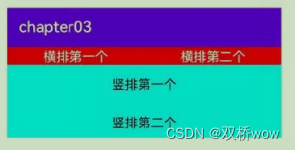
2.相对布局 RelativeLayout
线性布局的下级视图是顺序排列的,另一种相对布局的下级视图位置由其他视图决定。相对布局需要指定参照物,一种是下级视图平级的视图,另一种是该视图的上级视图,也就是它归属的RelativeLayout。
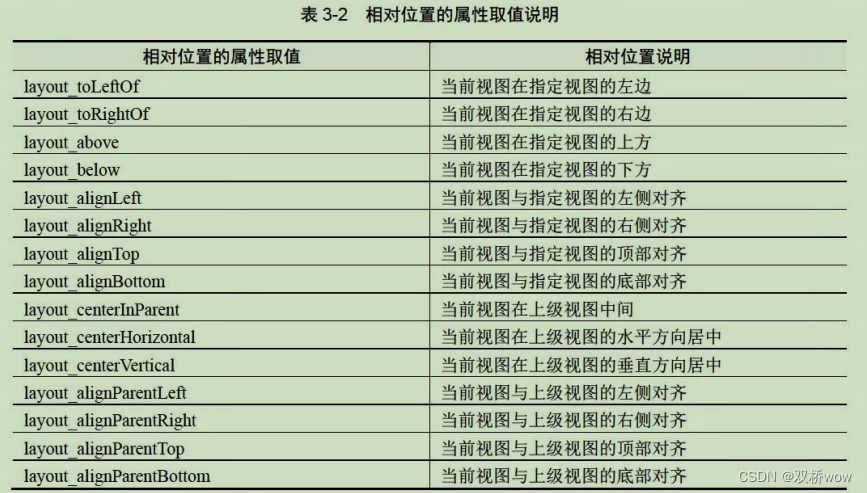
<RelativeLayout xmlns:android="http://schemas.android.com/apk/res/android"
android:layout_width="match_parent"
android:layout_height="150dp" >
<TextView
android:id="@+id/tv_center"
android:layout_width="wrap_content"
android:layout_height="wrap_content"
android:layout_centerInParent="true"
android:background="#ffffff"
android:text="我在中间"
android:textSize="11sp"
android:textColor="#000000" />
<TextView
android:id="@+id/tv_center_horizontal"
android:layout_width="wrap_content"
android:layout_height="wrap_content"
android:layout_centerHorizontal="true"
android:background="#eeeeee"
android:text="我在水平中间"
android:textSize="11sp"
android:textColor="#000000" />
<TextView
android:id="@+id/tv_center_vertical"
android:layout_width="wrap_content"
android:layout_height="wrap_content"
android:layout_centerVertical="true"
android:background="#eeeeee"
android:text="我在垂直中间"
android:textSize="11sp"
android:textColor="#000000" />
<TextView
android:id="@+id/tv_parent_left"
android:layout_width="wrap_content"
android:layout_height="wrap_content"
android:layout_alignParentLeft="true"
android:background="#eeeeee"
android:text="我跟上级左边对齐"
android:textSize="11sp"
android:textColor="#000000" />
<TextView
android:id="@+id/tv_parent_right"
android:layout_width="wrap_content"
android:layout_height="wrap_content"
android:layout_alignParentRight="true"
android:background="#eeeeee"
android:text="我跟上级右边对齐"
android:textSize="11sp"
android:textColor="#000000" />
<TextView
android:id="@+id/tv_parent_top"
android:layout_width="wrap_content"
android:layout_height="wrap_content"
android:layout_alignParentTop="true"
android:background="#eeeeee"
android:text="我跟上级顶部对齐"
android:textSize="11sp"
android:textColor="#000000" />
<TextView
android:id="@+id/tv_parent_bottom"
android:layout_width="wrap_content"
android:layout_height="wrap_content"
android:layout_alignParentBottom="true"
android:background="#eeeeee"
android:text="我跟上级底部对齐"
android:textSize="11sp"
android:textColor="#000000" />
<TextView
android:id="@+id/tv_left_center"
android:layout_width="wrap_content"
android:layout_height="wrap_content"
android:layout_toLeftOf="@+id/tv_center"
android:layout_alignTop="@+id/tv_center"
android:background="#eeeeee"
android:text="我在中间左边"
android:textSize="11sp"
android:textColor="#000000" />
<TextView
android:id="@+id/tv_right_center"
android:layout_width="wrap_content"
android:layout_height="wrap_content"
android:layout_toRightOf="@+id/tv_center"
android:layout_alignBottom="@+id/tv_center"
android:background="#eeeeee"
android:text="我在中间右边"
android:textSize="11sp"
android:textColor="#000000" />
<TextView
android:id="@+id/tv_above_center"
android:layout_width="wrap_content"
android:layout_height="wrap_content"
android:layout_above="@+id/tv_center"
android:layout_alignLeft="@+id/tv_center"
android:background="#eeeeee"
android:text="我在中间上面"
android:textSize="11sp"
android:textColor="#000000" />
<TextView
android:id="@+id/tv_below_center"
android:layout_width="wrap_content"
android:layout_height="wrap_content"
android:layout_below="@+id/tv_center"
android:layout_alignRight="@+id/tv_center"
android:background="#eeeeee"
android:text="我在中间下面"
android:textSize="11sp"
android:textColor="#000000" />
</RelativeLayout>效果
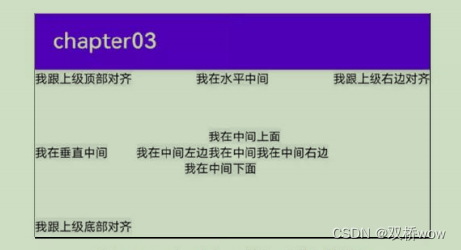
3.网格布局 GridLayout
线性布局只支持单行单列的布局方式,网格布局支持多行多列的布局方式。网格布局默认从左到右,从上到下排列,它先从第一行从左往右放置下级视图,塞满之后另起一行放置其余的下级视图。如此循环直至所有视图放置完毕,为了判断能够容纳几行几列,网格布局新增了android:columnCount与android:rowCount两个属性,其中columnCount指定了网格的列数,rowCount指定了网格的行数。网格布局xml示例:
<!-- 根布局为两行两列的网格布局,其中列数由columnCount指定,行数由rowCount指定 -->
<GridLayout xmlns:android="http://schemas.android.com/apk/res/android"
android:layout_width="match_parent"
android:layout_height="match_parent"
android:columnCount="2"
android:rowCount="2">
<TextView
android:layout_width="180dp"
android:layout_height="60dp"
android:gravity="center"
android:background="#ffcccc"
android:text="浅红色"
android:textColor="#000000"
android:textSize="17sp" />
<TextView
android:layout_width="180dp"
android:layout_height="60dp"
android:gravity="center"
android:background="#ffaa33"
android:text="橙色"
android:textColor="#000000"
android:textSize="17sp" />
<TextView
android:layout_width="180dp"
android:layout_height="60dp"
android:gravity="center"
android:background="#00ff00"
android:text="绿色"
android:textColor="#ffffff"
android:textSize="17sp" />
<TextView
android:layout_width="180dp"
android:layout_height="60dp"
android:gravity="center"
android:background="#660066"
android:text="深紫色"
android:textColor="#ffffff"
android:textSize="17sp" />
</GridLayout>效果:

4.滚动视图 ScrollView
滚动视图也分为垂直方向和水平方向两类,其中垂直滚动视图名为ScrollView,水平滚动视图名为HorizontalScrollView。
(1)在垂直方向滚动时,layout_width属性值设置为match_parent,layout_height属性值设置为wrap_content。
(2)在水平方向滚动时,layout_width设置为wrap_content,layout_height属性值设置为match_parent。
(3)滚动视图节点下面必须且只能挂着一个子布局节点,否则会在运行时报错。
示例:
<LinearLayout xmlns:android="http://schemas.android.com/apk/res/android"
android:layout_width="match_parent"
android:layout_height="match_parent"
android:orientation="vertical">
<!-- HorizontalScrollView是水平方向的滚动视图,当前高度为200dp -->
<HorizontalScrollView
android:layout_width="wrap_content"
android:layout_height="200dp">
<!-- 水平方向的线性布局,两个子视图的颜色分别为青色和黄色 -->
<LinearLayout
android:layout_width="wrap_content"
android:layout_height="match_parent"
android:orientation="horizontal">
<View
android:layout_width="1000dp"
android:layout_height="match_parent"
android:background="#aaffff" />
<View
android:layout_width="1000dp"
android:layout_height="match_parent"
android:background="#ffff00" />
</LinearLayout>
</HorizontalScrollView>
<!-- ScrollView是垂直方向的滚动视图,当前高度为自适应 -->
<ScrollView
android:layout_width="match_parent"
android:layout_height="wrap_content">
<!-- 垂直方向的线性布局,两个子视图的颜色分别为绿色和橙色 -->
<LinearLayout
android:layout_width="match_parent"
android:layout_height="wrap_content"
android:orientation="vertical">
<View
android:layout_width="match_parent"
android:layout_height="400dp"
android:background="#00ff00" />
<View
android:layout_width="match_parent"
android:layout_height="400dp"
android:background="#ffffaa" />
</LinearLayout>
</ScrollView>
</LinearLayout>效果:
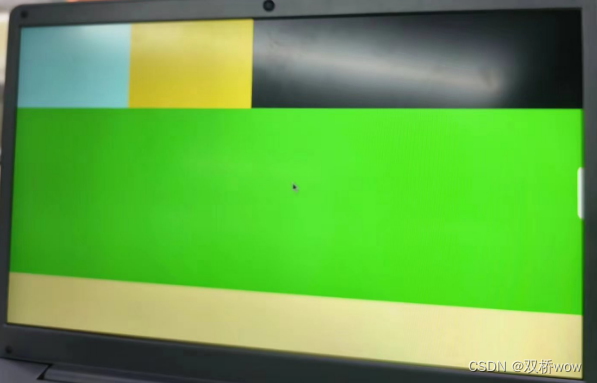




















 839
839











 被折叠的 条评论
为什么被折叠?
被折叠的 条评论
为什么被折叠?








